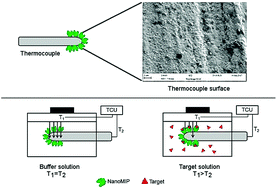A novel thermal detection method based on molecularly imprinted nanoparticles as recognition elements†
Abstract
Molecularly Imprinted Polymers (MIPs) are synthetic receptors that are able to selectively bind their target molecule and, for this reason, they are currently employed as recognition elements in sensors. In this work, MIP nanoparticles (nanoMIPs) are produced by solid-phase synthesis for a range of templates with different sizes, including a small molecule (biotin), two peptides (one derived from the epithelial growth factor receptor and vancomycin) and a protein (trypsin). NanoMIPs are then dipcoated on the surface of thermocouples that measure the temperature inside a liquid flow cell. Binding of the template to the MIP layer on the sensitive area of the thermocouple tip blocks the heat-flow from the sensor to the liquid, thereby lowering the overall temperature measured by the thermocouple. This is subsequently correlated to the concentration of the template, enabling measurement of target molecules in the low nanomolar regime. The significant improvement in the limit of detection (a magnitude of three orders compared to previously used MIP microparticles) can be attributed to their high affinity, enhanced conductivity and increased surface-to-volume ratio. It is the first time that these nanosized recognition elements are used in combination with thermal detection, and it is the first report on MIP-based thermal sensors for determining protein levels. The developed thermal sensors have a high selectivity, fast measurement time (<5 min), and data analysis is straightforward, which makes it possible to monitor biomolecules in real-time. The set of biomolecules discussed in this manuscript show that it is possible to cover a range of template molecules regardless of their size, demonstrating the general applicability of the biosensor platform. In addition, with its high commercial potential and biocompatibility of the MIP receptor layer, this is an important step towards sensing assays for diagnostic applications that can be used in vivo.



 Please wait while we load your content...
Please wait while we load your content...